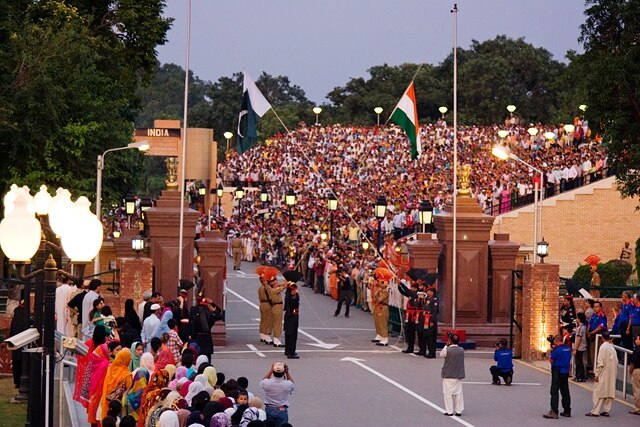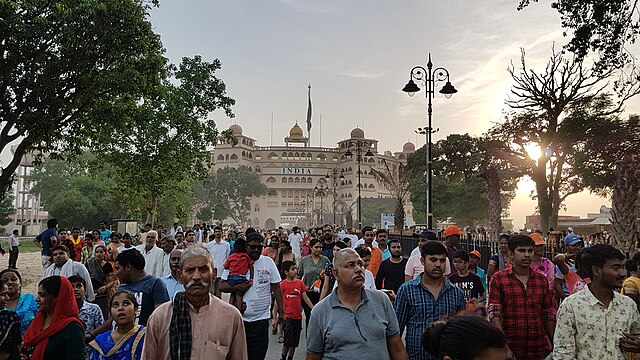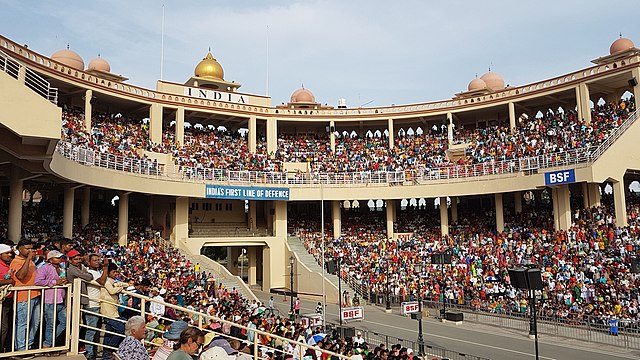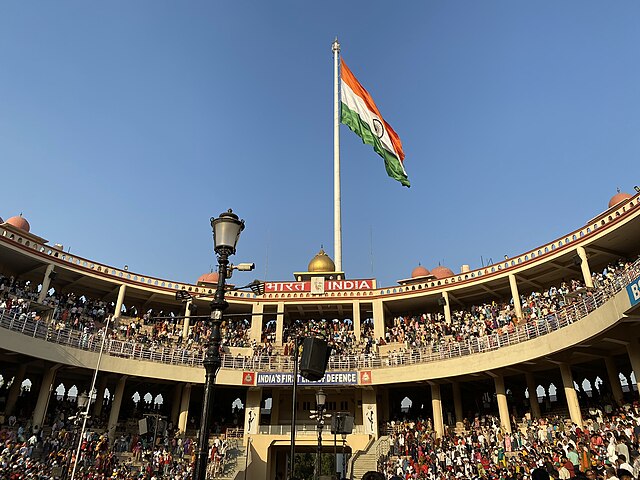Have you ever wondered what it’s like to witness one of the world’s most dramatic border ceremonies? The Wagah Border, standing as a symbol of both division and unity between India and Pakistan, offers visitors an unforgettable experience that combines patriotism, pageantry, and pure spectacle. But here’s the thing – timing is everything when it comes to visiting this iconic location.
Whether you’re a history buff, a curious traveler, or someone looking to experience the famous Beating Retreat Ceremony, understanding the Wagah Border timings is crucial for planning your visit. Let’s dive deep into everything you need to know about when, how, and what to expect during your journey to this remarkable place.
What is Wagah Border?
The Wagah Border isn’t just any ordinary international crossing – it’s a living theater of diplomatic relations between two nations. Located about 32 kilometers from Amritsar in Punjab, India, and 24 kilometers from Lahore in Pakistan, this border post has become synonymous with the daily flag-lowering ceremony that draws thousands of spectators.
Think of it as the world’s most intense military parade compressed into 45 minutes of pure adrenaline. The border crossing serves as the only road link between India and Pakistan, making it not just a tourist attraction but also a vital connection point between the two countries.
Understanding the Historical Significance
The history of Wagah Border stretches back to the partition of India in 1947. Named after the village of Wagah, which was divided during partition, this border has witnessed decades of political tensions, diplomatic negotiations, and countless human stories. The daily ceremony began in 1959 and has continued almost uninterrupted, becoming a powerful symbol of the complex relationship between India and Pakistan.
What makes this place truly special is how it transforms from a formal border crossing during the day into an amphitheater of national pride every evening. It’s like watching history unfold in real-time, with each ceremony carrying the weight of decades of shared history and separate destinies.
Current Wagah Border Timings 2025

Now, let’s get to the heart of the matter – when exactly can you visit Wagah Border? The timings vary based on seasons, and trust me, you don’t want to show up at the wrong time and miss the spectacular ceremony.
The border operates on different schedules throughout the year, primarily adjusted for daylight hours and weather conditions. Understanding these timings is like having the key to unlock the best possible experience at this incredible location.
Summer Timings (April to September)
During the summer months, when the sun sets later and temperatures soar, the ceremony timings are adjusted accordingly:
- Ceremony Start Time: 5:15 PM (IST)
- Gates Open: 3:00 PM
- Entry Closes: 4:45 PM
- Border Crossing Hours: 10:00 AM to 4:00 PM (for authorized personnel and traders)
The summer schedule takes advantage of the longer daylight hours while ensuring the ceremony doesn’t conflict with the scorching afternoon heat. Remember, summers in Punjab can be brutal, with temperatures often exceeding 40°C (104°F).
Winter Timings (October to March)
Winter brings cooler temperatures and earlier sunsets, which means adjusted timings:
- Ceremony Start Time: 4:15 PM (IST)
- Gates Open: 2:00 PM
- Entry Closes: 3:45 PM
- Border Crossing Hours: 10:00 AM to 4:00 PM (for authorized personnel and traders)
Winter is actually the preferred time for many visitors because of the pleasant weather and comfortable viewing conditions. You won’t be battling the intense heat, and the ceremony feels more enjoyable when you’re not sweating through your clothes.
Special Occasion Timings
During national holidays, festivals, or special events, timings might be modified. Independence Day (August 15) and Republic Day (January 26) often see extended ceremonies or special programs. It’s always wise to check current timings before your visit, as authorities occasionally adjust schedules for security reasons or special events.
Beating Retreat Ceremony Schedule
The Beating Retreat Ceremony is the crown jewel of any Wagah Border visit. This isn’t just a simple flag-lowering – it’s a choreographed display of military precision, national pride, and theatrical drama that leaves spectators spellbound.
The ceremony follows a strict timeline that’s been refined over decades. Guards from both sides engage in synchronized marching, aggressive posturing, and precise movements that symbolize both competition and cooperation between the two nations.
What Happens During the Ceremony?
Picture this: As the sun begins to set, guards in elaborate uniforms begin their ritualistic march. The Indian Border Security Force (BSF) and Pakistani Rangers face off in what can only be described as the world’s most civilized form of showing off.
The ceremony includes high kicks that would make Rockettes jealous, synchronized gate operations, and flag-lowering procedures conducted with military precision. Spectators cheer, wave flags, and sing patriotic songs, creating an atmosphere that’s part sports event, part cultural celebration, and part diplomatic theater.
The entire spectacle lasts about 45 minutes, but every minute is packed with action. From the initial march to the final handshake between guards, it’s a masterclass in pageantry that somehow manages to be both intimidating and friendly at the same time.
Best Time to Arrive for Optimal Viewing
Here’s insider knowledge that can make or break your experience: arrive early, but not too early. Getting there when the gates open gives you the best seat selection, especially if you want to sit in the VIP section (which requires separate tickets).
However, arriving 30 minutes before the ceremony starts is usually sufficient for general seating. The key is understanding that once you’re inside, you’re committed to staying until the ceremony ends – and trust me, you won’t want to leave anyway.
Entry Requirements and Procedures
Visiting Wagah Border isn’t like strolling into a regular tourist attraction. This is an active international border with strict security protocols that you absolutely must follow.
Think of the entry process as going through airport security, but with the added complexity of being at a sensitive border location. The authorities take security seriously, and for good reason – this is where two nuclear powers meet every single day.
Required Documents for Indian Citizens
Indian citizens need to carry valid photo identification. Acceptable documents include:
- Aadhaar Card
- Voter ID Card
- Driving License
- Passport
- PAN Card
Students should carry their school or college ID cards along with any government-issued photo ID. The key is having clear, current identification that matches your appearance – no expired documents or photocopies.
Entry Process for Foreign Nationals

Foreign visitors face additional requirements and restrictions. Here’s what international tourists need to know:
Foreign nationals must carry their original passport with a valid Indian visa. Additionally, they need to inform the BSF authorities in advance about their visit plans. Some nationalities might face restrictions or require special permissions, so checking with local authorities or your hotel concierge is highly recommended.
Security Check Timings
Security checks begin when the gates open and continue until entry closes. The process typically takes 15-30 minutes, depending on crowd size and security protocols. During peak tourist seasons or special events, allow extra time for security procedures.
How to Reach Wagah Border
Getting to Wagah Border is relatively straightforward, but planning your transportation is crucial since you’re working with fixed ceremony timings that won’t wait for delayed travelers.
From Amritsar
Amritsar serves as the primary base for most Wagah Border visitors, and for good reason – it’s close, well-connected, and offers plenty of accommodation options.
Transportation Options
By Taxi or Private Car: This is the most convenient option, taking about 45 minutes to 1 hour depending on traffic. Expect to pay ₹800-1200 for a round trip, including waiting time.
By Bus: Punjab Roadways operates regular buses from Amritsar to Wagah. These are economical but less flexible with timing. The journey takes about 1 hour.
By Auto-rickshaw: Three-wheelers are available but not recommended for the full journey due to distance and comfort considerations.
Tour Packages: Many local operators offer Wagah Border tour packages that include transportation, entry arrangements, and sometimes additional sightseeing.
From Delhi and Other Major Cities
Long-distance travelers have several options:
By Flight: Fly to Amritsar (Sri Guru Ram Dass Jee International Airport), then proceed by road to Wagah.
By Train: Multiple trains connect major cities to Amritsar, including the popular Golden Temple Mail and Swarna Shatabdi Express.
By Road: National highways connect Amritsar to major cities. The drive from Delhi takes about 6-7 hours via NH44.
What to Expect During Your Visit

Your Wagah Border experience begins long before the ceremony starts. Understanding what to expect helps you prepare mentally and practically for this unique adventure.
The atmosphere is electric from the moment you enter the complex. Patriotic songs play over loudspeakers, vendors sell national flags and souvenirs, and the excitement is palpable. It’s like being at a cricket match where everyone’s on the same team.
Seating Arrangements
The viewing area is divided into different sections:
VIP Section: Requires advance booking and offers the best views. Tickets cost more but provide comfort and premium positioning.
General Seating: Free entry with basic seating arrangements. Arrive early for better spots.
Standing Area: For overflow crowds during peak times.
Women and families often get priority seating in designated sections, making the experience more comfortable for diverse visitors.
Photography Guidelines
Photography is allowed in designated areas, but there are strict rules:
- No photography of military installations or personnel without permission
- Drone photography is strictly prohibited
- Video recording during the ceremony is generally allowed from spectator areas
- Professional equipment might require special permissions
The key is respecting security guidelines while capturing your memories. Most visitors find that smartphones are perfectly adequate for documenting their experience.
Essential Tips for Visitors
Success at Wagah Border comes down to preparation and realistic expectations. Here are insider tips that can transform your visit from good to unforgettable.
What to Bring and What to Avoid
Essential Items to Bring:
- Valid photo ID (absolutely mandatory)
- Water bottle (stays can be long)
- Sunglasses and hat (especially during summer)
- Comfortable walking shoes
- Small bag for personal items
- Cash for souvenirs and refreshments
Items to Avoid:
- Large bags or backpacks (security restrictions)
- Outside food (usually not permitted)
- Alcohol or smoking materials
- Sharp objects or anything that could be considered a weapon
- Excessive electronic equipment
Weather Considerations
Punjab’s weather can be extreme, so dressing appropriately is crucial:
Summer Visits: Light, breathable clothing, sun protection, and plenty of water. The concrete seating can get uncomfortably hot.
Winter Visits: Layers are key since temperatures can drop significantly after sunset. A light jacket or sweater is recommended.
Monsoon Season: Rain gear might be necessary, though ceremonies rarely get cancelled due to weather.
Nearby Attractions and Accommodations
Your Wagah Border visit can be part of a larger Punjab experience. The region offers numerous attractions that complement your border adventure.
The Golden Temple in Amritsar is an obvious pairing – it’s one of India’s most beautiful and spiritually significant sites. The Jallianwala Bagh memorial provides historical context, while the vibrant streets of Amritsar offer incredible food and shopping opportunities.
Accommodation options range from budget guesthouses to luxury hotels in Amritsar. Many visitors prefer staying near the Golden Temple area, which offers easy access to both the temple and transportation to Wagah Border.
Local restaurants serve authentic Punjabi cuisine that’s perfect for fueling up before your border adventure. Don’t miss trying local specialties like sarson da saag, makki di roti, and the famous Amritsari kulcha.
Conclusion
Visiting Wagah Border is more than just watching a ceremony – it’s experiencing a piece of living history that continues to evolve with each passing day. Understanding the timings, requirements, and logistics ensures you can focus on soaking in this remarkable spectacle rather than worrying about practical details.
The Beating Retreat Ceremony represents something unique in our world: a place where political tensions transform into theatrical performance, where military precision becomes entertainment, and where national pride gets expressed through synchronized marching and flag ceremonies. It’s simultaneously serious and playful, formal and festive, intense and celebratory.
Whether you’re drawn by curiosity about Indo-Pakistani relations, love of military pageantry, or simply want to witness something truly unique, Wagah Border delivers an experience you’ll remember long after you’ve returned home. Just remember to check those timings, bring your ID, and prepare for an adventure that perfectly captures the complexity and humanity of this remarkable region.
Frequently Asked Questions (FAQs)
1. Can I visit Wagah Border without watching the ceremony?
Yes, you can visit during regular border crossing hours (10 AM to 4 PM), but you’ll miss the main attraction. Most tourists specifically come for the Beating Retreat Ceremony, as it’s the highlight of any Wagah Border visit.
2. Is advance booking required for the ceremony?
Advance booking is only required for VIP seating. General admission is first-come, first-served and free of charge. However, arriving early ensures better seating positions for the ceremony.
3. Are there any age restrictions for visitors?
There are no specific age restrictions, but parents should consider that the ceremony can be loud and crowded. Small children might find the experience overwhelming, especially during peak tourist seasons.
4. What happens if the ceremony gets cancelled?
Ceremonies are rarely cancelled and typically continue regardless of weather conditions. In extreme cases involving security concerns or national emergencies, authorities might suspend operations, but this is uncommon.
5. Can Pakistani citizens visit from the Indian side?
Pakistani nationals cannot cross from the Indian side as tourists. The border crossing is restricted to authorized personnel, traders with permits, and individuals with special diplomatic clearances. Regular tourism across the border is not permitted.

